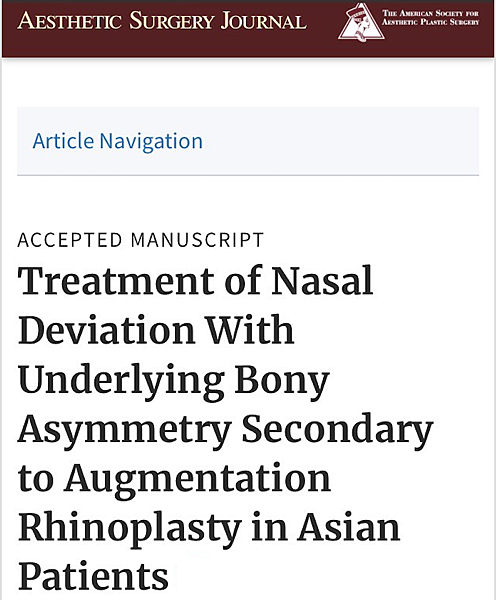BLOG
部落格本診所張睿紘醫師最新論文發表--隆鼻後困難歪鼻的矯正

本診所張睿紘醫師於第七屆長庚國際美容論壇 ( 7th International Chang Gung Aesthetic Conference)演講---術後困難歪鼻之矯正 (
在本診所通力合作下,由張睿紘醫師當第一通訊作者,寫成論文,
論文中將本診所的對於鼻整形術後歪鼻的電腦斷層掃描診斷,

Figure 3. This 37-year-old woman with postaugmentation nasal asymmetry received revisional rhinoplasty based on results of CT. (A, B) CT findings indicate deviation of the keystone region owing to poorly performed nasal osteotomy in the primary procedure. Note the consequent tilting of the dorsal calcified rib cartilage graft. The green line in (A) indicates the midline axis ascertained from photographic analysis. The blue line in (B) specifies the level of the axial slice imaged in (A).

Abstract
BACKGROUND:
In Asian patients, nasal deviation secondary to augmentation rhinoplasty may result from underlying bony asymmetry that was not corrected intraoperatively. Diagnosis and treatment of this condition are complicated by the masking effect of dorsal implants.
OBJECTIVES:
The authors applied computed tomography (CT) to examine the causes of nasal deviation after augmentation rhinoplasty. CT results were utilized in preoperative planning for revisional surgery.
METHODS:
Fifteen women with nasal deviation after augmentation rhinoplasty and CT-confirmed bony asymmetry were included in a retrospective study. To correct nasal deviation, the authors performed revisional rhinoplasty with paramedian osteotomy and unilateral placement of extended spreader grafts at the concave side of the keystone region. For patients with concomitant glabella-radix deviation, implants comprising expanded polytetrafluoroethylene or autologous fascia were placed.
RESULTS:
Of the 15 patients with nasal bony asymmetry, 14 had developmental keystone asymmetry, and 1 had osteotomy-induced keystone deviation. Six patients had developmental glabella asymmetry. Patients received follow-up for an average of 11.2 months (range, 6-24 months). Revisional procedures were considered successful in 13 patients; 2 patients required additional surgery to address residual nasal deviation.
CONCLUSIONS:
CT is valuable for the diagnosis of postaugmentation nasal deviation owing to underlying bony asymmetry. Paramedian osteotomy with extended spreader grafting at the concave side of the keystone area and correction of the glabella-radix deviation are effective procedures to reposition the nasal axis along the midline of the face.
回上一頁看更多文章

